24 Common Types of Trees in Illinois (with Pictures)
-
Jessica Rossetti
- Last updated:
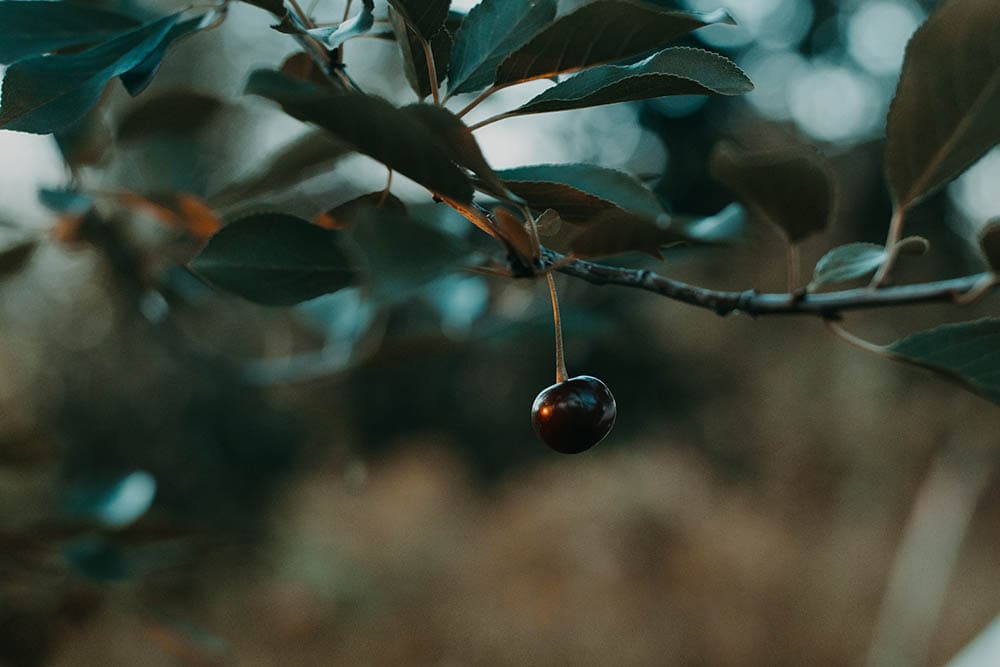
The Prairie State is known for its forests, farmlands, forests, and hills. If you’re familiar with Illinois or have simply driven through the state, you know that there are countless trees everywhere you look. Over 250 species can be found in Illinois, including native and introduced trees. Over 75% of the state’s wildlife make their homes in these trees, with over 120 bird species nesting in Illinois’ forests.
Below, we’ll discuss 24 of the most common trees in Illinois so you can learn more about them. The next time that you’re in Illinois, you may be able to recognize a few of these beauties!
The 24 Common Types of Trees in Illinois
1. White Oak
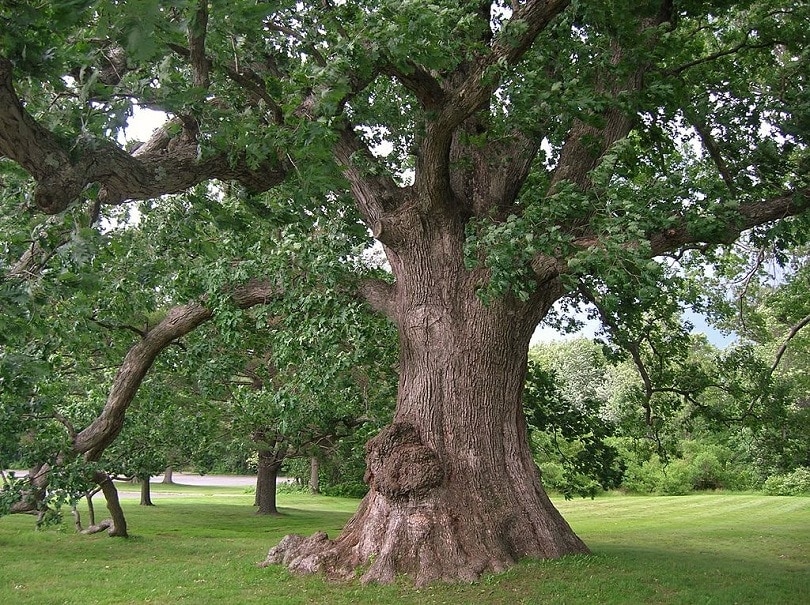
| USDA Hardiness Region: | 3–9 |
| Sun: | Full sun |
| Mature Size: | 60–100 feet tall, 50–90 feet wide |
The White Oak tree is the state tree of Illinois. These trees play a significant role in local ecosystems because they provide food and homes for many wildlife species. This tree is a beautiful addition to any landscape. It’s also very large!
The White Oak can grow 100 feet tall and 90 feet wide, and it’s sure to attract many species of birds, butterflies, and pollinators. Young White Oak trees can do well in partial shade, but mature trees need full sun to stay healthy and show a wide range of fall colors. The trees can tolerate frigid or high temperatures, making them excellent options for the Illinois climate.
- Tolerates all climates
- Provides habitats and food to local wildlife
- Pleasing aesthetic
- Requires full sun to grow at its best
- Requires adequate room for growth
2. Red Maple
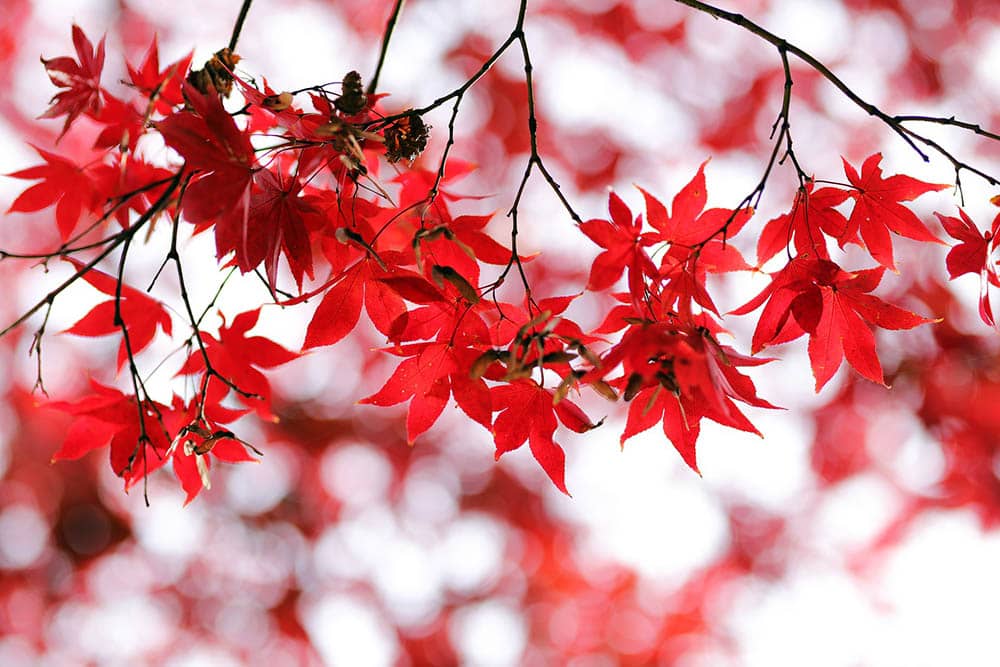
| USDA Hardiness Region: | 2–9 |
| Sun: | Full sun/partial shade |
| Mature Size: | 40–60 feet tall, 40 feet wide |
The Red Maple is a common landscape tree due to its beautiful coloring and rounded crown. The green leaves turn red in the fall, ranging from crimson to burgundy. The tree is native to the eastern United States and Canada. Like many other Maple trees, the Red Maple produces the samara fruit.
You’ll see the seeds flying through the air, commonly called “helicopters,” wrapped in green leaves resembling wings. The seeds have evolved to travel far distances to increase the chances of repopulation.
- Creates a beautiful landscape
- Can be grown in sun or partial shade
- Helicopter seeds can get everywhere
3. American Elm
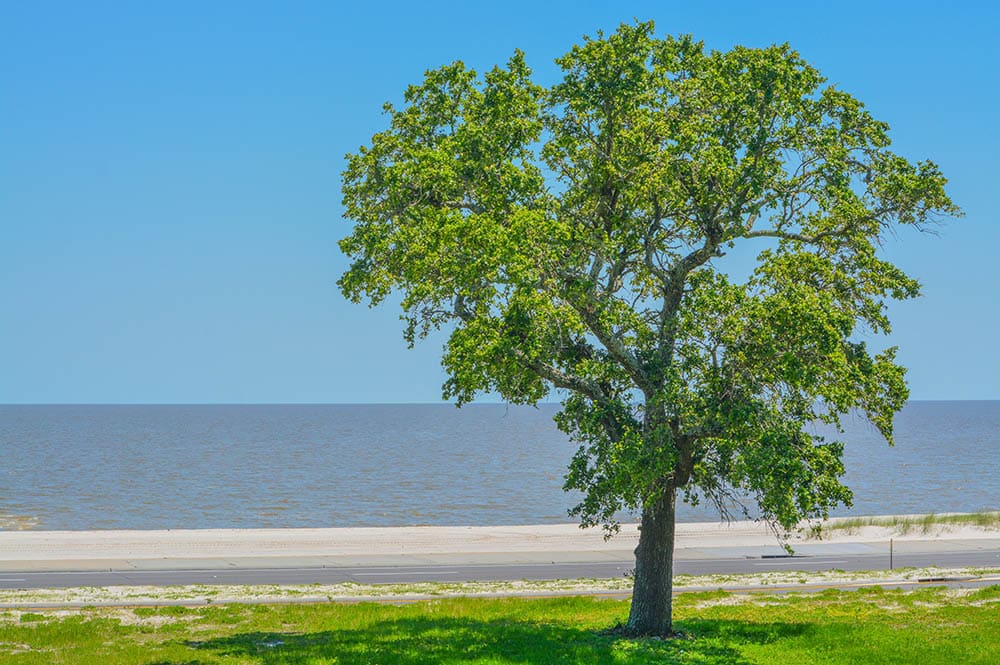
| USDA Hardiness Region: | 3–9 |
| Sun: | Full sun |
| Mature Size: | 80–130 feet tall, 60–120 feet wide |
The graceful American Elm tree has branches that spread like fountains, and its leaves turn golden in the fall. It was a favorite tree in the 19th century, and many paths and streets were lined with American Elms in the 20th century. The trees provide shade and produce samara seeds that get dispersed with the wind.
Unfortunately, many American Elm trees were destroyed by Dutch elm disease in the 1950s. This fungus is spread from tree to tree by elm bark beetles that feed on them. The disease taught planters that various species should be planted along streets, parks, and landscapes so one disease or pest can’t destroy every tree.
- Beautiful, lush coverage
- Popular and widely recognized
- Susceptible to Dutch Elm Disease
4. River Birch
| USDA Hardiness Region: | 4–9 |
| Sun: | Full sun/moderate shade |
| Mature Size: | 30–60 feet tall, 20–50 feet wide |
The River Birch tree is a common sight along the western edge of Illinois and throughout southern Illinois. It’s seen alongside streams, growing well in alluvial soils formed by running water. Young tree trunks are usually pink or light brown, with a curling bark that easily peels away to show tan or reddish inner bark. Older trees have bark that is gray to black.
River Birches often have multiple branches growing from the trunk that must be pruned. Pruning too early can cause sap to leak and form an unsightly mess. Pruning in the fall after the tree has lost its leaves can keep the sap to a minimum. During fall, the oval-shaped leaves turn red, orange, and yellow.
- Provides shade alongside water
- Ornamental tree produces a graceful silhouette
- Sap can be messy and unsightly
5. Locust
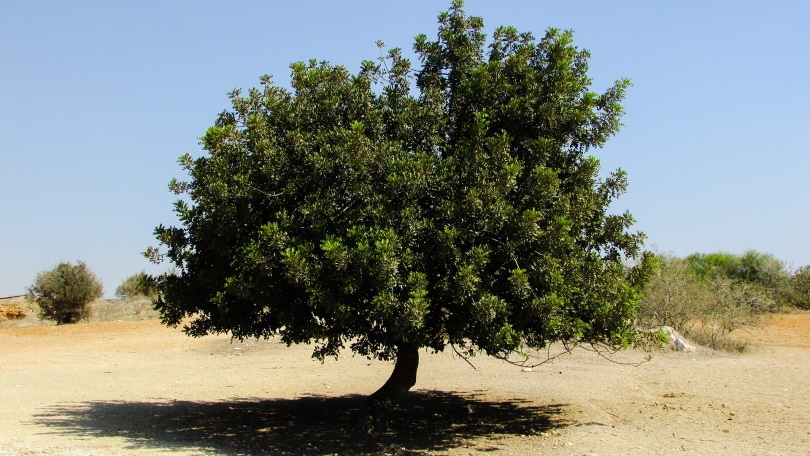
| USDA Hardiness Region: | 4–9 |
| Sun: | Full sun |
| Mature Size: | 40–80 feet tall, 60–100 feet wide |
Two types of Locust trees are commonly seen in Illinois: the Honey Locust tree and the Black Locust tree. Each tree has thorns that grow on the branches. The trees produce fragrant flowers that grow in drooping clusters and are green, white, pink, or purple, depending on the type of tree.
The leaves are green in the spring and turn yellow in the fall. The trees’ thorns help protect them from predators, but they are still susceptible to various diseases and harmful insects like the locust borer and the honey locust plant bug. These insects damage leaves and bark, which can weaken the trees.
- Produces pretty, fragrant flowers
- Has a natural defense system of thorns
- Susceptible to diseases and invasive insects
6. Crabapple
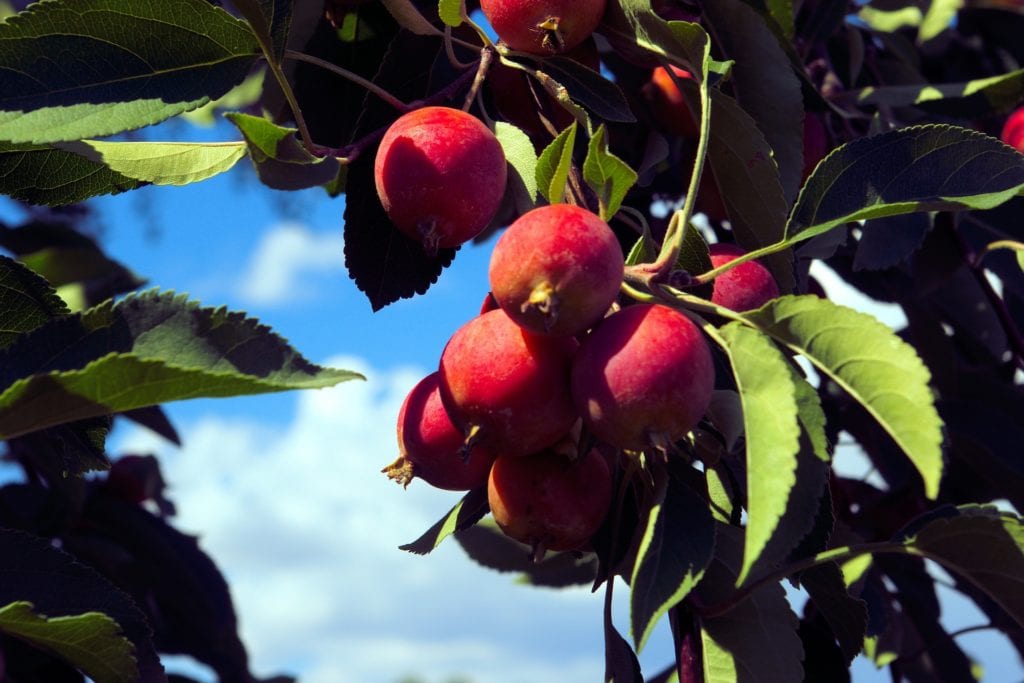
| USDA Hardiness Region: | 4–8 |
| Sun: | Full sun |
| Mature Size: | 5–20 feet tall, 10–20 feet wide |
There are hundreds of Crabapple tree varieties, and many of them are popular throughout Illinois. These small trees are easy to plant to fill out landscapes. They produce white, pink, or red flowers. Leaves change from green to orange, red, or gold in the fall.
The edible crabapples are red and small, resembling cherries. Some varieties of crabapples can be yellow, orange, or purple. The trees are susceptible to diseases like mildew and scab and pests like the Japanese beetle.
- Small landscape tree
- Produces beautiful flowers and edible fruit
- Vulnerable to diseases and insects
7. Black Willow
| USDA Hardiness Region: | 4–9 |
| Sun: | Full sun/partial shade |
| Mature Size: | 30–60 feet tall, 30–60 feet wide |
Black Willow trees are native to Illinois and grow in wet conditions. They grow quickly and can live for up to 50 years. The tree requires pruning to keep it controlled. You can usually find Black Willows in parks and residential areas throughout the state. They serve as homes to various species of birds and pollinators.
Unfortunately, the roots of these trees can cause damage to sewer systems. The trees are also vulnerable to ice damage. Since they are such fast growers, mindful planting is necessary with Black Willows.
- Long lifespan
- Thrives in wet conditions
- Susceptible to ice damage
- Invasive roots
8. Blue Ash
| USDA Hardiness Region: | 4–7 |
| Sun: | Full sun |
| Mature Size: | 50–75 feet tall, 25–35 feet wide |
Healthy Blue Ash trees can live for up to 150 years. They are primarily seen in the southeast section of Illinois, identified by their rounded, irregular crowns and bluish-gray bark. The twigs of this tree are square, another distinguishing feature. The tree’s name comes from the blue dye produced when the inner bark comes in contact with water.
The sap from the Healthy Blue Ash also turns blue when it’s exposed to the air. The tree produces heavy, firm wood that is usually used for flooring. The Blue Ash is a threatened species due to the emerald ash borer, an exotic woodboring beetle that can destroy Ash trees.
- Distinguishing features
- Used for flooring
- Threatened status
9. Mockernut Hickory
| USDA Hardiness Region: | 6–8 |
| Sun: | Full sun |
| Mature Size: | 60–70 feet tall, 20–30 feet wide |
The Mockernut Hickory is also called the White Hickory and can be found in the dry forests of Illinois. It can be identified by its dark-gray bark with a diamond pattern of ridges. It produces greenish-yellow leaves with hairy upper and lower surfaces.
The tree grows flowers that form in drooping clusters and oval nuts around 2 inches long. The nuts ripen in the fall and are eaten by wild animals. Mockernut Hickory wood is typically used for fence posts and tool handles, but the wood is prone to splitting at the annual rings.
- Provides nuts for wildlife
- Produces flowers
- Wood may split
10. Red Mulberry
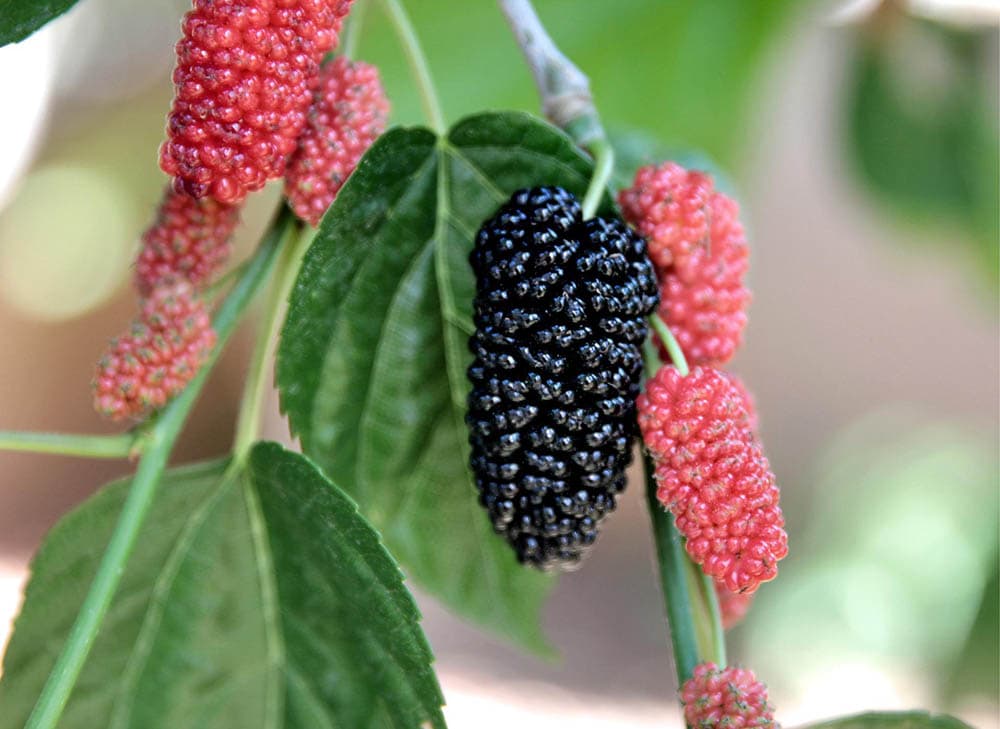
| USDA Hardiness Region: | 3–8 |
| Sun: | Full sun/partial shade |
| Mature Size: | 35–50 feet tall, 30–40 feet wide |
The Red Mulberry tree is a popular shade tree because of its many branches at the crown. It thrives throughout Illinois and the United States. Red Mulberries are commonly seen in moist forests or along streams on well-draining soil. The tree’s bark is yellowish-brown, turning orangish-grey as the tree matures.
The Red Mulberry produces clusters and spikes of greenish-yellow flowers. The berries are also formed in clusters and start red, turning dark purple as they ripen. They serve as food for animals and even people, but they easily fall from the tree and can stain your property. Decks, patios, cars, and clothing can end up with a reddish residue that is hard to remove.
- Popular shade tree
- Produces food for wildlife
- The red berries can stain your surroundings
11. American Redbud
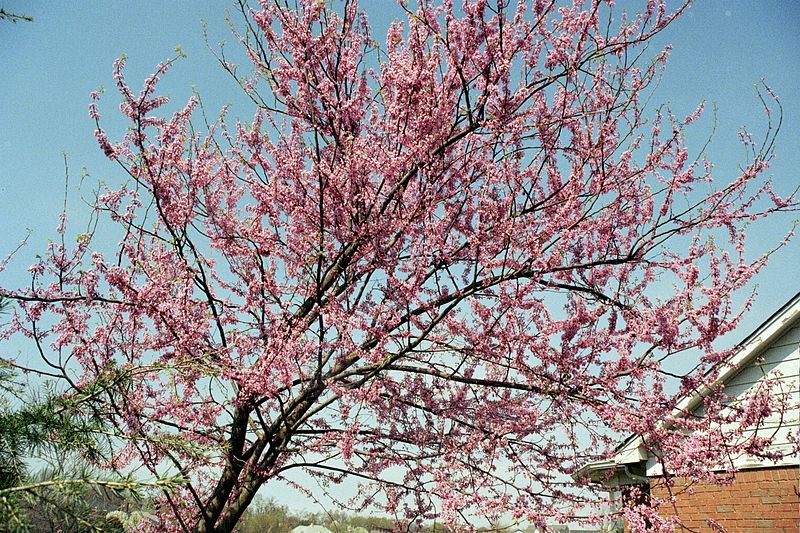
| USDA Hardiness Region: | 4–9 |
| Sun: | Full sun/partial shade |
| Mature Size: | 20–30 feet tall, 25–35 feet wide |
The American Redbud is a short tree with a short lifespan. However, it produces beautiful, fragrant, pink flowers in April. The leaves change from purple to dark green to yellow. They form a wide-spreading crown, making them suitable options for shade trees in areas with power lines or where large trees would be impractical.
The flowers attract pollinators and butterflies, but the trees need regular pruning. They also don’t bloom more than once per year. They need plenty of water to maintain their health, or insects or animals can eat them.
- Short lifespan
- Produces lovely, fragrant flowers
- Great for pollinators
- Needs regular pruning
- Blooms only once a year
12. Sassafras
| USDA Hardiness Region: | 4–9 |
| Sun: | Full sun/partial shade |
| Mature Size: | 30–60 feet tall, 25–40 feet wide |
The Sassafras tree produces a lovely, aromatic fragrance. They are known for their autumn colors, changing from deep green leaves in the summer to deep yellow, orange, purple, and scarlet red in the fall. Their crowns resemble mittens.
The Sassafras produces small, dark-blue fruit in the fall that serves as food for wildlife. Unfortunately, it can attract the Japanese beetle, which deposits a fungus into the tree’s sap. Over time, this fungus can kill the tree. If the tree remains healthy, it can live for over 30 years.
- Long lifespan
- Produces beautiful fall colors
- Provides food for wildlife
- Can be damaged or killed by the Japanese beetle
13. Flowering Dogwood
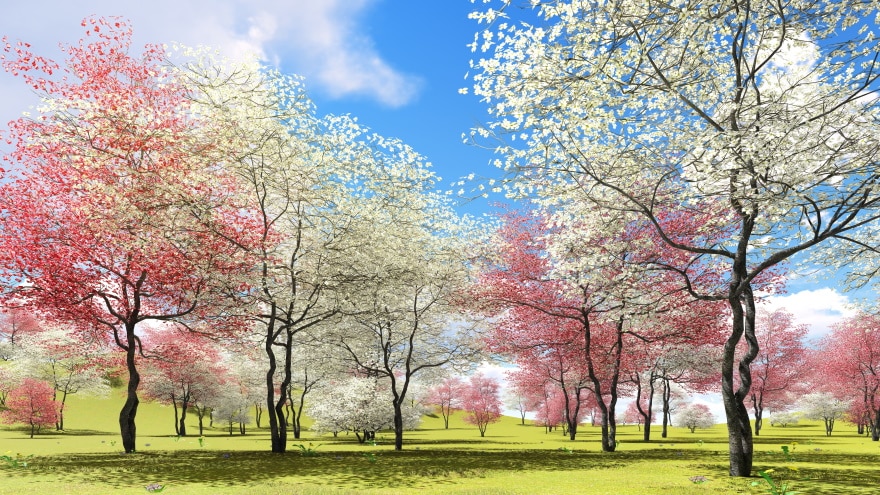
| USDA Hardiness Region: | 5–9 |
| Sun: | Full sun |
| Mature Size: | 20–40 feet tall, 25–30 feet wide |
Flowering Dogwood trees have white flowers that bloom in April or May. They are small, decorative trees with oval-shaped, smooth leaves. In the fall, the leaves turn scarlet and purple. The Flowering Dogwood also produces red berries that grow in clusters, which can remain on the trees in the winter.
They are eaten by wildlife and migrating birds. While Dogwoods are beautiful, they’re delicate. They don’t tolerate pruning well and are susceptible to decay and fungal infections. If the tree is damaged, it heals slowly.
- Produces flowers
- Provides berries for wildlife
- Small and decorative
- Easily damaged
- Heals slowly
14. Silver Maple
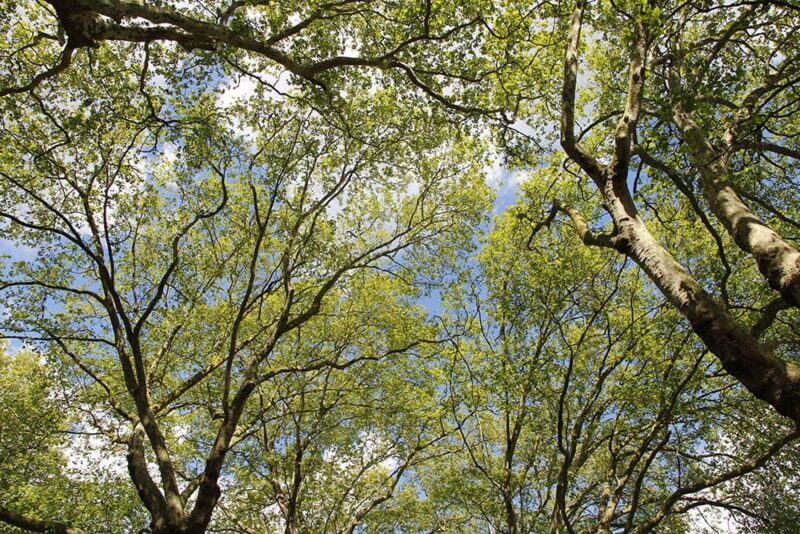
| USDA Hardiness Region: | 3–9 |
| Sun: | Full sun |
| Mature Size: | 60–100 feet tall, 50–90 feet wide |
The Silver Maple tree is a common sight in Illinois and is often used as a shade tree. Its silver underside can appear to shimmer in the sunlight. They have a moderate drought tolerance, and their blooms serve bees and other pollinators. The trees produce seeds that are eaten by wildlife.
The roots of Silver Maples can damage sewer systems and sidewalks, so the trees are no longer commonly planted. They also have soft wood that can be easily damaged and is prone to grub infestations. Hybrids of the Silver Maple and other Maple trees, such as the Red Maple, have been created to form a more durable tree with a wider variety of fall colors. The Silver Maple’s leaves turn yellow, but he hbrid leaves turn yellow, red, and orange.
- Ideal shade tree
- Important for wildlife and pollinators
- Easily damaged
- Destructive roots
15. Sycamore

| USDA Hardiness Region: | 4–9 |
| Sun: | Full sun |
| Mature Size: | 70–100 feet tall, 65–80 feet wide |
Sycamore trees are also called Buttonwood or Buttonball trees. Each winter, balls approximately 1 inch wide grow from the tree branches and fall to the ground in the spring. These trees are commonly used for shade in parks or along stream banks but are usually too big for residential use. They create litter on sidewalks, and their roots can cause damage to sidewalks and paths.
The Sycamore tree is identified by its bark. It peels off, leaving a camouflage pattern of brown outer bark on white wood. Older Sycamores are susceptible to fungal diseases. If the diseases don’t kill the tree, the wood will be attacked, making the tree weak and hollow. Hollow Sycamore trees serve as shelter and areas for wildlife to store food.
- Provides shade for large areas
- Bark creates beautiful patterns
- Serves wildlife in various ways
- Susceptible to disease
- Invasive roots
16. Eastern White Pine
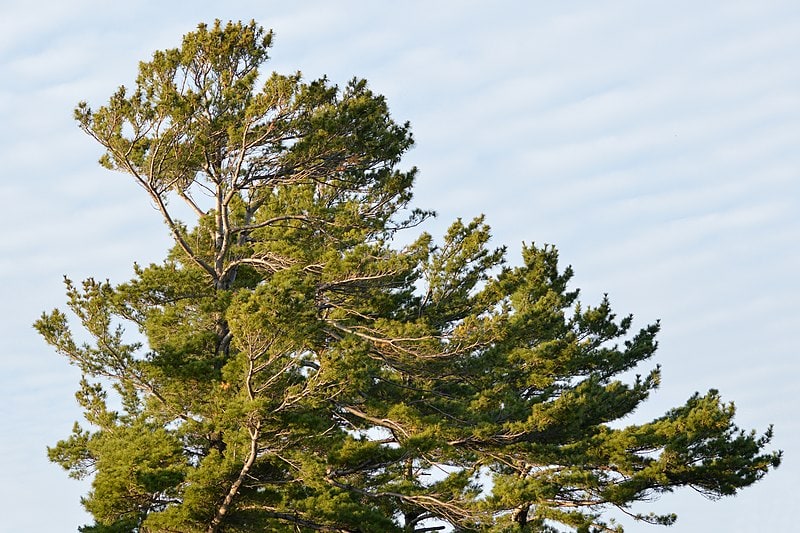
| USDA Hardiness Region: | 3–8 |
| Sun: | Full sun/partial shade |
| Mature Size: | 50–80 feet tall, 20–40 feet wide |
Eastern White Pine trees are hardy and form clusters of bluish-green needles. The trees grow quickly, increasing more than 2 feet in height each year. The Eastern White Pine is a widely used option for a Christmas tree because of how quickly it grows and how easily it’s transported.
The trees also work well to block the wind. Various bird species make their nests in the trees, and the bark is eaten by wildlife like rabbits, beavers, and porcupines. If the tree stays healthy, it can live for over 1,000 years! They produce pinecones, which eventually fall from the tree along with the needles. Pine trees also are known for having sticky sap, which can attract insects that then damage the tree.
- Blocks wind
- Used for Christmas trees
- Provides homes and food for wildlife
- Sticky sap
- Generates plenty of pinecones
17. Blue Beech
| USDA Hardiness Region: | 3–9 |
| Sun: | Full sun/full shade |
| Mature Size: | 20–35 feet tall, 20–35 feet wide |
The Blue Beech is a small species found in the wet forests of Illinois and across the eastern United States. They have smooth, gray trunks that resemble flexed muscles, earning them the nickname “Musclewood.” They grow well in wet soil and tolerate periods of flooding.
The Blue Beech produces flowers in the spring and tiny nuts at the base of its leaves that ripen from August through October. Birds often eat the nuts. Since the tree is small, it isn’t normally used for wood. If the wood is used for certain products, it should be sealed well because it absorbs water and tends to crack after a few years. Beech is also more expensive than many other types of wood.
- Tolerates flooding
- Grows beautiful flowers
- Produces nuts
- Wood cracks over time
- Expensive wood
18. Black Walnut
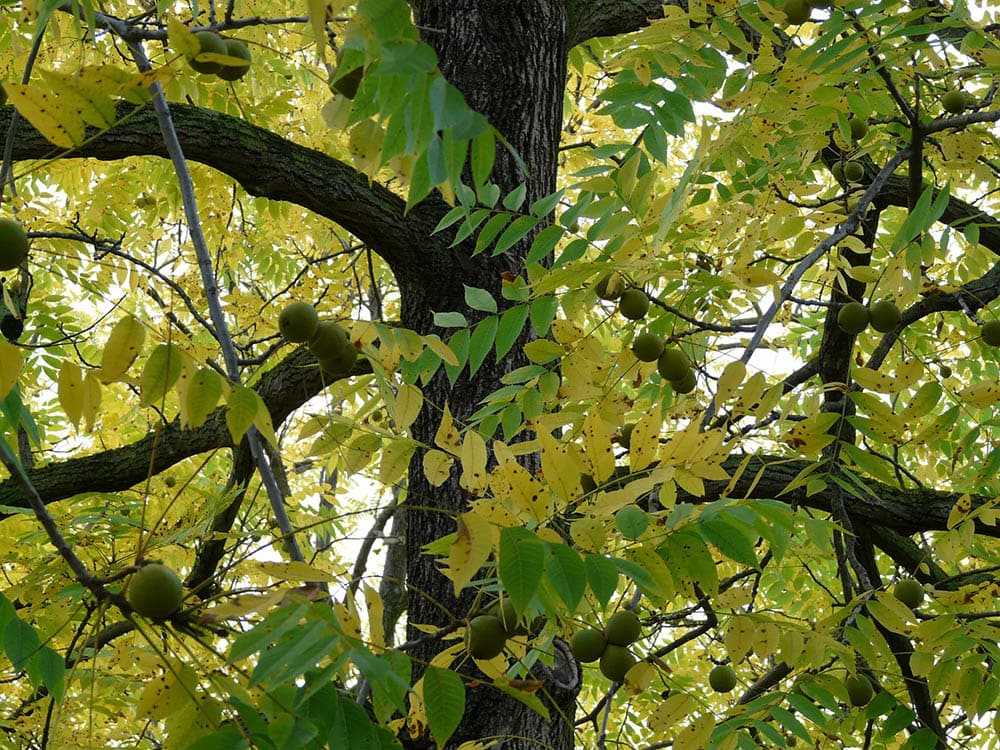
| USDA Hardiness Region: | 4–9 |
| Sun: | Full sun |
| Mature Size: | 50–75 feet tall, 30–50 feet wide |
The Black Walnut tree is native to the Chicago area and is used as a shade tree. The tree produces a chemical that will poison other plants, so it must be planted with caution. The tree produces nuts that serve as food for squirrels and other wildlife.
You’ll often see caterpillars on Black Walnuts because they attract butterflies. The bark is brown with thick ridges, and the leaves change from green to yellow in the fall. The nuts can be messy when they drop from the tree. Black Walnuts can be difficult to locate if you want to plant one.
- Provides food for wildlife
- Attracts butterflies
- Messy
- May be difficult to acquire
19. Box Elder
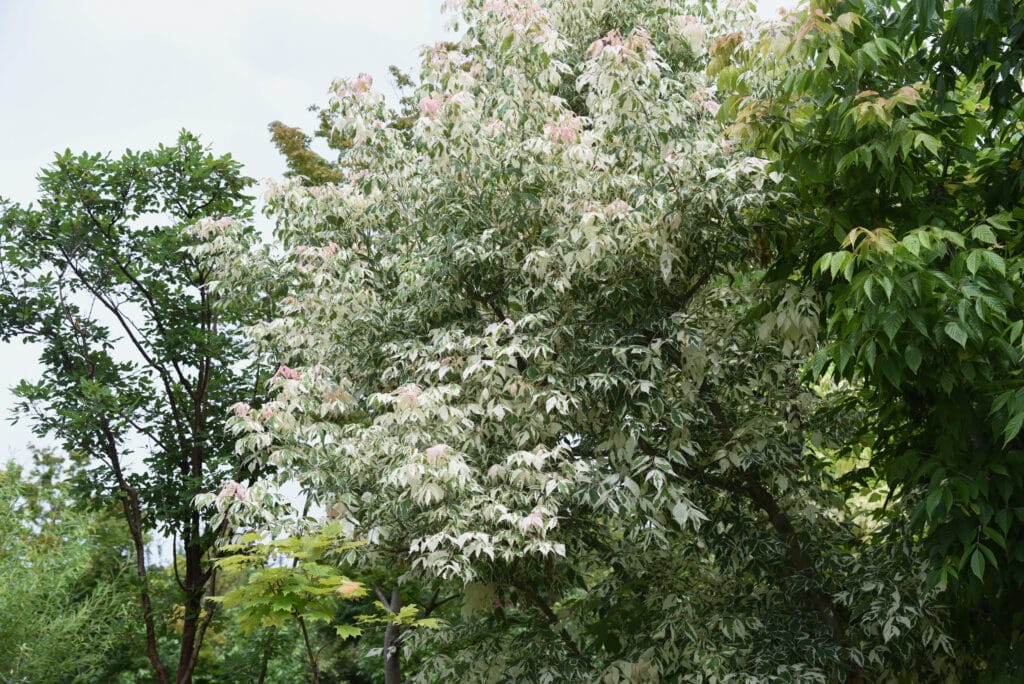
| USDA Hardiness Region: | 2–9 |
| Sun: | Full sun |
| Mature Size: | 30–50 feet tall, 30–50 feet wide |
The Box Elder tree is a Maple tree that grows quickly and is cold-hardy. It earns its name because it attracts box elder bugs. When the tree is mature, the wood is often weak and brittle. In the wild, Box Elders are considered helpful because they stabilize stream banks and give wildlife homes.
In cities, they are considered a weed. There are male and female Box Elder trees, but only the female trees bear fruit. The trees are often damaged by ice and can be messy because of their fruit and seeds.
- Fast-growing
- Tolerates cold
- Attracts bugs that will enter your home
- Weak wood
- Messy
20. Eastern Cottonwood
| USDA Hardiness Region: | 3–9 |
| Sun: | Full sun |
| Mature Size: | 150–200 feet tall, 50–75 feet wide |
The Eastern Cottonwood tree grows tall and has a spreading crown with hanging branches. They grow best in well-draining, fine soil. The bark is smooth and yellowish-gray when the tree is young. It becomes brownish-gray when the tree is mature.
The Eastern Cottonwood has one single trunk with coarse ridges. The leaves of the tree are shiny and glisten in the sunlight. The seeds are wrapped in cotton, which can be a significant source of allergies for some people. The cotton can also block vents and filters in homes and backyard pools. Their roots often break up sidewalks and damage the ground.
- Beautiful leaves
- Provides ample shade
- May trigger allergies
- Cotton is messy and can be damaging
21. Sweet Gum
| USDA Hardiness Region: | 5–9 |
| Sun: | Full sun |
| Mature Size: | 60–75 feet tall, 40–75 feet wide |
The Sweet Gum tree is interesting because it’s resistant to the toxicity of the Black Walnut tree. It produces unique leaves that are shaped like stars. They turn beautiful shades of red, purple, and yellow in the fall.
Sweet Gums produce small fruit covered in spines that change from green to brown as they ripen. Near sidewalks and residential areas, the trees drop loads of seeds that must be cleared away.
- Can live near Black Walnut trees
- Turns beautiful colors in the fall
- Sheds fruit that can be messy
22. Black Cherry
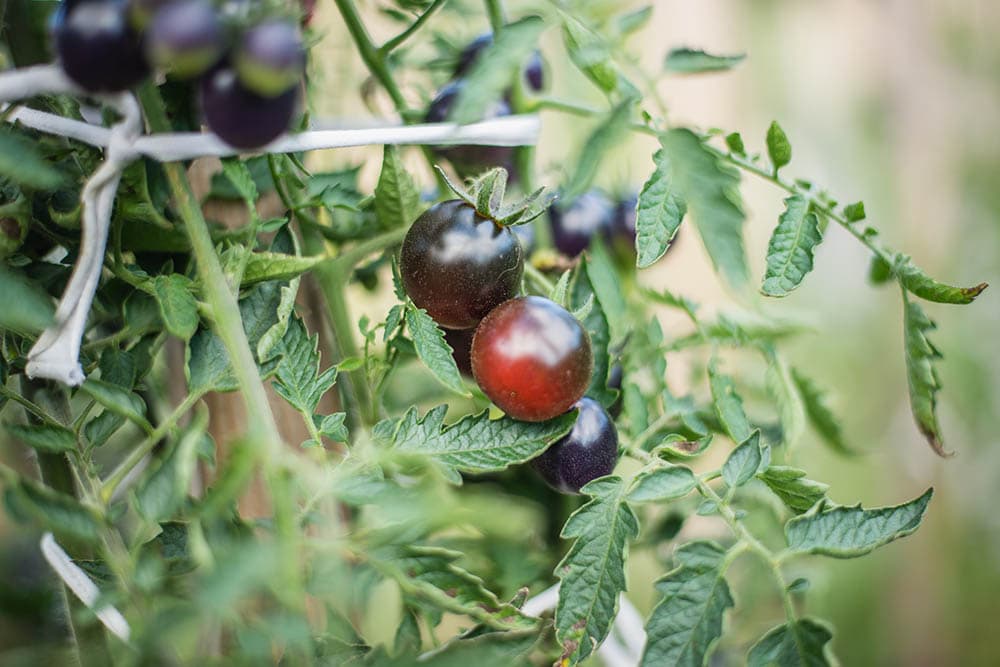
| USDA Hardiness Region: | 3–9 |
| Sun: | Full sun/partial shade/shade |
| Mature Size: | 50–60 feet tall, 20–30 feet wide |
The Black Cherry tree is native to the Midwest and part of the Rose family. They are primarily seen in residential areas and parks. The Black Cherry produces white flowers in early spring that develop into pea-sized cherries over the summer. When the cherries are ripe, they become a dark purplish-black color.
Some people find the fragrance of the flowers to be unpleasant. The bark is quite dark, nearly black. While the trees are homes to nesting birds and other animals, they can be messy to maintain and are susceptible to ice damage. The cherries can stain whatever they land on and are difficult to remove.
- Produces cherries
- Provides homes for wildlife
- Messy
- Can be damaged by ice
23. Magnolia

| USDA Hardiness Region: | 4–9 |
| Sun: | Full sun/partial shade |
| Mature Size: | 60–80 feet tall, 40–50 feet wide |
Magnolia trees are large and have been around for millions of years. The Magnolia Acuminata is the only species native to Illinois, but there are eight species native to the United States.
Magnolias are known for their lovely, waxy flowers that bloom in the summer. The flowers are cup-shaped and have a floral, lemony scent often used in aromatherapy. The downside to Magnolia is that it’s often damaged by frost.
- Known for its flowers
- Offers a pleasant fragrance
- Ornamental addition to a landscape
- Frost can damage the tree
24. Hackberry
| USDA Hardiness Region: | 3–9 |
| Sun: | Full sun |
| Mature Size: | 40–60 feet tall, 40–60 feet wide |
The Hackberry tree can withstand a broad range of temperatures and climates. It’s a durable tree that resembles an American Elm. It grows quickly and forms a vase shape, so it’s commonly used as a shade tree in residential areas.
It produces berries that are food for wildlife and can tolerate periods of flooding and drought. A downside to the Hackberry is that it’s susceptible to mold. If the tree molds, it will turn the entire tree black, leaving you with no choice but to have it removed.
- Tolerates various climates
- Provides good shade coverage
- Produces berries
- Susceptible to mold
Conclusion
We hope you’ve enjoyed learning about some of the most common trees in Illinois. Whether for shade or ornamental purposes, each tree plays a vital role in the ecosystem and benefits landscapes around the state. Maybe you’ve even chosen a few to add to your property. Keep your eyes peeled for these trees the next time you’re in the Midwest, and see how many you can identify!
Featured Image Credit: Irina Iriser, Pexels
Contents
